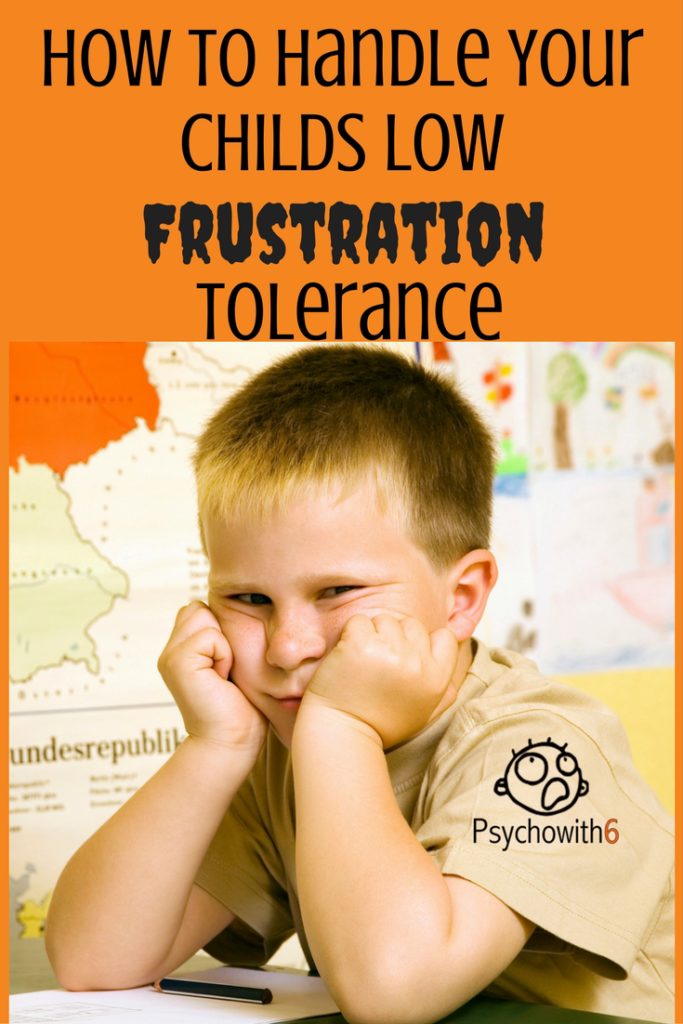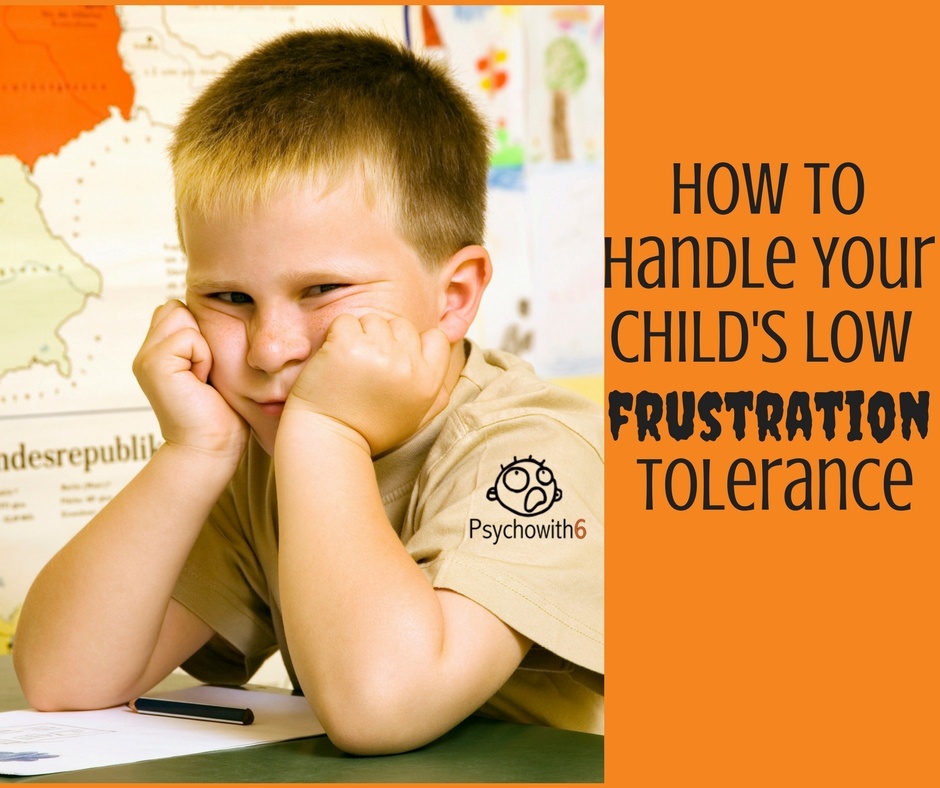When I answered a parent’s question about low frustration tolerance, I realized I had a lot to say on the subject. First, I want to define the problem and then I want to share six tips for teaching your child.
What is Low Frustration Tolerance?
When we are discussing low frustration tolerance, we aren’t talking about a child who easily gets quiet when challenged, are we? If a child withdraws to his room to read because he’s frustrated with the first few math problems he’s presented with, his mother is unlikely to complain. Low frustration tolerance means that a child gets frustrated easily. What most parents struggle with isn’t low tolerance, but poor frustration management. They generally aren’t concerned about when a child gets frustrated as much as they are with how they deal with it. I will be discussing how to help a child who yells, cries, or acts out when frustrated.
#1 Observe the situations that lead to frustration
Be an investigator rather than a mommy. We tend to feel helpless when our child tantrums. Our helplessness can lead to our own poor frustration management. We’re anxious about our child’s behavior and our inability to manage it. This is a problem. Children who have poor self-control have to know that you aren’t freaked out by their behavior. If they don’t have control, they want to know that you do. If you have to fake a sense of control, do it. Your anxiety is fuel on the fire of your child’s fit. Stay calm and rather than fretting, take note of what is happening.
By take note, I’m less interested in you observing her screaming, kicking, or crying. I’m more interested in your observation of what led to this behavior. Observe:
Sleep: did your child get enough sleep? My 3-year-old had a tantrum when we were in Disney World. That was not his typical behavior and was directly related to his not getting a nap. Take note of how your child responds to sleep deprivation.
Nutrition: How long has it been since your child ate? Could this be low blood sugar? I often see my husband being irritable when he’s hungry. Conversely, has your child had a lot of sugar? You may want to take note of any unusual foods eaten as well.
Change of routine: Did you do anything out of the ordinary in your schedule? For example, did you say no to something your child typically gets to enjoy? Have you just returned from vacation?
Interruption of fun: Did you demand that your child stop a fun activity or leave somewhere without giving adequate warning?
Too much input: Was your child around too many people, too much noise, or too many options?
Did someone or something keep your child from getting what he wants? Perhaps a younger sibling destroyed a Lego creation. Does your child have a physical or learning disability that makes achieving difficult? Did other children keep your child from playing?
This kind of observation can’t be done in a day. Keep good notes and you’ll likely discover a pattern to your child’s frustration. This is valuable information.
#2 Use your observations to avoid provoking frustration
We all get frustrated at times. We can’t avoid it completely, but we can certainly avoid provoking it unnecessarily. Let’s talk about being proactive in each of these areas.
Sleep: If your child is reactive to sleep deprivation, make regular bed and naptimes a priority. The fun of staying out late one night probably isn’t worth a hysterical child in your co-op the next day.
Nutrition: If your child reacts to low blood sugar, carry snacks with you and make sure your child has eaten before high-stress situations. If your child can’t handle a certain food or drink, look for an alternative that your child will enjoy.
Change of routine: Allow plenty of ease-in time when you are coming off a break. Don’t return to a full schedule immediately when your child doesn’t manage it well. Avoid unnecessary changes in routine and talk to your child about the necessary ones. Explain the change and give your child some choice in the change if at all possible. For example, if your preschooler is used to watching educational TV at a certain time and you know you won’t be home, explain that you will record the show and that she will be able to watch when you get home or after dinner — her choice.
Interruption of fun: Give your child more than one warning before ending the fun. Saying that you’ll be leaving a friend’s in 30 minutes and then 10 will help your child adjust.
Too much input: Avoid these situations for now. If they’re unavoidable, try to minimize them. For example, if you’re at a fun center, suggest that you spend time with your child in one area. Definitely avoid these situations if your child is already at risk for frustration. You don’t want to take a sleep-deprived, low-blood sugar child to an arcade.
Not getting what he wants: Make sure you address any physical concerns with your pediatrician. Difficulty seeing or hearing is frustrating. If frustration seems limited to certain subjects or skills, consider testing for learning disabilities. Many older children are relieved to know why certain work is so hard for them. If another child is interfering with your child’s fun, ask the parent to intervene or nicely intervene if the parent isn’t available. It’s very frustrating for a child not to have an advocate. If a specific social circle isn’t friendly, find a new one or join in the play with the kids to help your child fit in. You can imagine that I’ve barely scratched the surface of the kinds of things that can keep your child from getting what she wants.
#3 Prepare your child to encounter frustration
Once you’ve observed the situations that cause frustration and you’ve taken steps to avoid them, you’re ready to prepare a child to deal with the frustrations that are part of life. If you know your child is likely to be frustrated, tell him so. For example, “We are going to be playing at Joey’s house today and you know his little brother likes to play, too. One thing that might keep him from bothering you is to play with him first. He just wants to be included. After that, maybe you and Joey can play in Joey’s room and we’ll play with his brother. If he is bothering you, though, tell us right away, okay?”
Everyone copes better with challenging situations when they know what to expect. Be honest about the difficulties; don’t say things like, “It will be fine.” Rather, specifically state the kinds of things that may lead to frustration. Then affirm your belief in your child’s ability to cope. That leads me to step #4.
#4 Teach your child the signs of frustration
We expect our children to just know some things when they must be specifically taught. Most children who struggle with frustration management didn’t see the signs before their behavior was already out of control. The best way to do this is to talk about the physical signs you experience. These are some of my signs that may or may not apply to you. My shoulders get tense. I may hold them up closer to my ears and they feel tight and even sore. I may be frowning so much that I have a headache. My stomach may feel tight, too. As I get more frustrated, I start handling things roughly. I may pound the mouse on my desk or press hard with my pen.
Talk about the thinking signs of frustration that you experience. See if your child has these. I may think, “I can’t do it!”; “It’s not working”; “This is taking forever!”; “They’re driving me crazy!”.
Talk about the verbal signs of frustration and see if your child relates. I might raise my voice. I might ask people to leave me alone. I might tell people to be quiet. I may say, “Never mind!” or “You don’t understand.”
It’s a good idea to write down the specific signs of frustration your child has.
#5 Teach your child how to manage frustration
The best time to teach your child these skills is when he is not frustrated. He should be well rested and ready to learn.
Have your child imagine that she is starting to get frustrated. Use one of the situations you know is a trigger. She should close her eyes and picture it. She should notice the physical signs of frustration she would be likely to feel. Then have your child take a deep breath and let it out slowly. Have your child raise her shoulders to her ears and make the muscles as tight as possible, holding them there for several seconds. Then have her quickly drop her shoulders and let her arms hang like noodles at her side. Take another slow, deep breath in. Do the same thing with her forehead muscles. Have her lift her eyebrows toward her scalp and hold them there, making the forehead muscles tight. Then quickly drop the eyebrows. Take another slow, deep breath in.
Then ask your child for smart ways to manage frustration. Ask what she thinks of the following ideas if she doesn’t suggest them: taking a break; asking for help; praying; going outside.
Suggest new ways of thinking about the frustrating situation: “I can get help”; “I can do it with practice”; “It will be easier to do if I take a break”; “I can calm down if I walk away.”
Suggest new ways of verbalizing the frustration: “I can’t get this to work”; “I’m feeling frustrated”; “Can you help me?”; “Will you pray for me?”; “I need to be by myself for a while”; “I need a break.”
It may be frustrating for you to know that this training is going to require a lot of time. That leads me to step #6.
#6 Continue coaching your child in frustration management
When you notice the signs of frustration in your child (and you should be getting better at noticing them), you can intervene by noting your observations. Consider creating a stoplight sign. You would just put red, yellow, and green paper circles on a black piece of construction paper. Explain what you’re seeing and that it looks like your child is at a yellow level of frustration. Ask what your child needs to do to return to the green level. If your child is struggling, make a suggestion. You could suggest taking a deep breath, for example.
Another way to help your child notice the signs is to say what you’re seeing. “It looks like you’re having trouble getting this toy to work.” This is more helpful than saying, “You’re getting frustrated.” If you want to help, always get permission. Your child may be frustrated specifically because he wants to do it himself. If you fix it for him without permission, you’re likely to provoke a tantrum. Instead, ask, “Do you want me to help by holding this piece for you?” If the answer is no, you can continue to suggest options. “Do you think taking a break and coming back to it might help?” Do not take something away from the child in this situation. That will provoke him for sure. Always give your child the choice, unless there is danger involved.
I had a mother ask if she should allow her child to do what she wants or to set limits even if she knows it will provoke a tantrum. First, I recommend you listen to the episode on the #1 question homeschoolers ask me. Then your choice to do something that you know will frustrate your child depends on you. I’m not suggesting that we avoid ever making our children unhappy. That would be very poor parenting. But if you are highly stressed, haven’t had enough sleep, etc. and pulling your child off her favorite game means she will pitch a fit, I am all for avoiding a confrontation. However, this choice of giving in to your child cannot become a pattern. Children have to learn to manage frustration in order to survive and thrive.
You can succeed in teaching your child to manage frustration. Start by observing what provokes frustration. What have you noticed? Let’s chat about it on Facebook.









